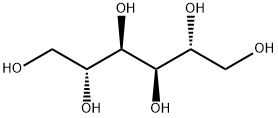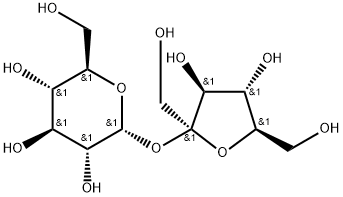Mannitol , Super pure level, ≥99.0%(HPLC) , 69-65-8
Synonym(s):
D -Mannitol;Mannite;Mannitolum;Parteck Mannitol
CAS NO.:69-65-8
Empirical Formula: C6H14O6
Molecular Weight: 182.17
MDL number: MFCD00064287
EINECS: 200-711-8
| Pack Size | Price | Stock | Quantity |
| 100G | RMB49.60 | In Stock |
|
| 500G | RMB98.40 | In Stock |
|
| others | Enquire |
PRODUCT Properties
| Melting point: | 167-170 °C(lit.) |
| Boiling point: | 295°C |
| alpha | 141 º (c= USP-directives) |
| Density | 1.52 |
| bulk density | 400-500kg/m3 |
| refractive index | 1.3330 (estimate) |
| Flash point: | 290-295°C/3.5mm |
| storage temp. | 2-8°C |
| solubility | H2O: 1 M at 20 °C, clear, colorless |
| form | Crystalline Powder |
| pka | 13.5(at 18℃) |
| color | White |
| Odor | at 100.00 %. odorless |
| PH | 5.0-6.5 (25℃, 1M in H2O) |
| optical activity | [α]25/D +23.3 to +24.3°(lit.) |
| Odor Type | odorless |
| biological source | plant |
| Water Solubility | soluble |
| λmax | λ: 260 nm Amax: 0.04 λ: 280 nm Amax: 0.04 |
| Merck | 14,5745 |
| BRN | 1721898 |
| Stability: | Stable. Combustible. Incompatible with strong oxidizing agents. |
| InChIKey | FBPFZTCFMRRESA-KVTDHHQDSA-N |
| LogP | -3.262 (est) |
| CAS DataBase Reference | 69-65-8(CAS DataBase Reference) |
| NIST Chemistry Reference | D-Mannitol(69-65-8) |
| EPA Substance Registry System | D-Mannitol (69-65-8) |
Description and Uses
Mannitol is a white, crystalline solid consisting of D-mannitol and a small quantity of sorbitol. It is odorless and has a sweet taste. It is soluble in water, very slightly soluble in alcohol, and practically insoluble in most other common organic solvents. It is prepared commercially by catalytic reduction of glucose. Mannitol occurs in small amounts in a variety of foods such as olives, beets, and celery, and in the exudate of certain trees.
D-Mannitol is used in the food industry as anticaking and free-flow agent, flavo ring agent, lubricant and release agent, stabilizer and thickener and nutritive sweetener.
Used in titrimetric determination of boric acid in the manufacture of dry electrolytic condensers for radio applications;
Used in making artificial resins and plasticizers.
Safety
| Symbol(GHS) |  GHS07 |
| Signal word | Warning |
| Hazard statements | H302+H312+H332 |
| Precautionary statements | P280 |
| Hazard Codes | Xi |
| Risk Statements | 36/37/38 |
| Safety Statements | 24/25-36-26 |
| WGK Germany | 2 |
| RTECS | OP2060000 |
| F | 3 |
| Autoignition Temperature | 410 °C |
| TSCA | Yes |
| HS Code | 29054300 |
| Hazardous Substances Data | 69-65-8(Hazardous Substances Data) |
| Toxicity | LD50 orally in Rabbit: 13500 mg/kg |



